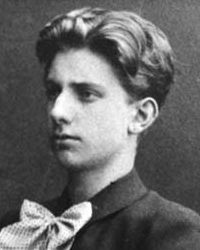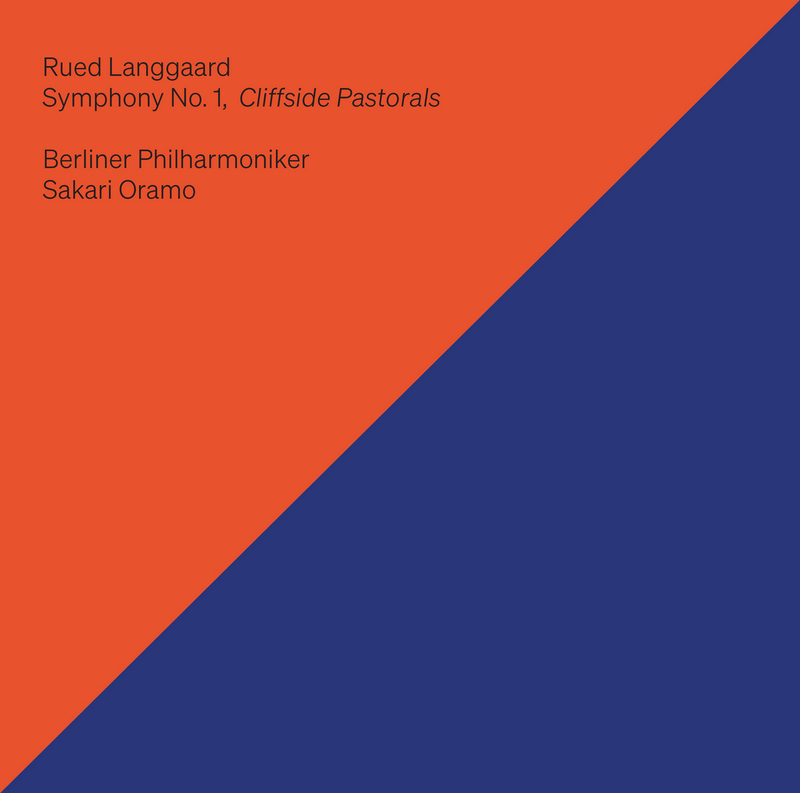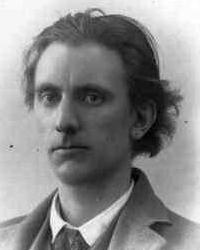
110 years ago today, something extraordinary took place in Berlin. During the previous few years, the young Danish composer Rued Langgaard had been working on his first symphony. He began it in early 1908, at the age of 14, and completed it the following year, though he continued revising the score for a couple more years. By 1910 he had begun attempts to organise a performance, but in his own country the work’s ambitious scale and complexity were such that it was immediately deemed to be unplayable; a subsequent trip to Sweden to try his luck there met with the same result. The solution came from Germany: Langgaard’s family holidayed in Berlin each year during this period, and on their trip in 1911 they got to know the newly-appointed leader of the Berlin Philharmonic (Julius Thornberg), who was also Danish, and who ensured that chief conductor Arthur Nikisch got to see the score. Instantly impressed, it was soon agreed that the Berlin Philharmonic would première the symphony, which they did at the Philharmonie on 10 April 1913.
It’s no exaggeration to say that Langgaard’s Symphony No. 1 is surely the most ambitious and radical symphony ever to come from the pen of such a young composer. Structurally, the work bears certain similarities with Mahler’s Seventh Symphony, featuring five movements in which the middle three are shorter and more contemplative, bookended by large, tempestuous outer movements, grand in scope. But it’s the work’s musical language that’s most impressive, bringing to mind – and somehow making a convincing synthesis of – the high romanticism of Wagner, Strauss, Bruckner, Mahler, Scriabin and Enescu. Names like those should give some indication of the heady, at times overblown, levels of intensity captured in this remarkable work. In later years Langgaard would subtitle the piece “Klippepastoraler” (Cliff pastorals), due to the fact that its five movements are inspired by the idea of a journey starting from the base of cliffs, hiking up to the top of a mountain. Such a concept instantly evokes Strauss’ Alpine Symphony, though it’s worth remembering that Langgaard’s Symphony No. 1 was premièred two years before that piece.
The Berlin Philharmonic only performed the symphony on that one occasion, and Langgaard was unable to convince Danish orchestras to take on the work. It would finally receive a performance in Denmark a decade-and-a-half later, in April 1928, conducted by Langgaard himself, after which, incredibly and tragically, Symphony No. 1 fell into obscurity. Over 60 years would then pass before it was resurrected and recorded for the first time, by the Artur Rubenstein Philharmonic Orchestra conducted by Ilya Stupel. Released by Danacord in 1992, this was the opening instalment in what would become the first complete cycle of Langgaard’s 16 symphonies. A second recording followed two years later courtesy of the Danish National Radio Symphony Orchestra under Leif Segerstam, released by Chandos. The same orchestra, now renamed as the Danish National Symphony Orchestra, recorded the symphony again with Thomas Dausgaard, released by DaCapo in 2008, as part of another complete cycle. Most recently, at the end of last year DaCapo released a recording of a live performance given by the original orchestra that premièred the work, the Berlin Philharmonic, conducted by Sakari Oramo.

Both of the earliest two releases are problematic. Ilya Stupel’s recording embraces Langgaard’s youthful ebullience in what is the fastest account so far (55:22), though it’s let down somewhat by the sonics which don’t allow all the details – and there’s a lot of them – to come through clearly. The Artur Rubenstein Philharmonic are clearly having a blast, though while enthusiasm counts for a lot in this piece, there are times, particularly in the final movement, when they sound like they’re not quite up to all of the symphony’s challenges.
By contrast, Leif Segerstam’s recording is the longest so far (67:16 – almost 12 minutes longer), and that’s entirely down to the fact that he opts to luxuriate in Langgaard’s intoxicating soundworld. There’s no denying the power, beauty and ultra-vivid clarity of this performance – the first and last movements are at times genuinely astonishing – but the slow pace ultimately detracts from and tends to dissipate the dauntless energy of the music.
Thomas Dausgaard charts an absolutely superb middle path between these two interpretations (his account runs 60:29). In his hands the symphony is just itching to get moving, impetuous and passionate. He ensures that the Danish National Symphony Orchestra makes the most of the strange dissonances, oblique structural tangents and sumptuous lyricism, above all stitching the five movements into a single, cohesive narrative that leaves one constantly excited about what’s coming next. Throughout, there’s a real sense of the breathlessness of a teenage composer barely able to hold onto musical coherence in an epic struggle to get the symphony out.
This new release from the Berlin Philharmonic and Sakari Oramo really gives the Dausgaard a run for its money. Oramo boldly approaches the symphony with the same attitude as Stupel (the performance lasts 55:30, almost as quick) making it abundantly clear in the opening moments of just how fervid things are going to be. Indeed, the first movement, ‘Brændinger og Solglimt’ (Surf and Glimpses of Sun), launches with such muscular zeal it’s as if the symphony begins in medias res. Along the way they beautifully bring out Langgaard’s unusual orchestrational touches, such as the string swooshes that accompany the waltz-like second subject – a beautiful melody that’s only heard here and in the recapitulation; for the rest of the movement the opening motif dominates everything – sounding like the rush of swirling fabric in the midst of a dance. The climaxes are given Mahlerian scale, making a feature of their courageous, almost post-tonal harmonic pile-ups and the impression – now invoking Scriabin – of music that’s both overwhelming and absolutely unstoppable. Langgaard’s cliffs have here become epic, soaring peaks.
The contrasting three inner movements are rendered as exquisite, immersive tableaux. ‘Fjeldblomster’ (Mountain Flowers), a late romantic equivalent of Mahler’s excised early ‘Blumine’ movement, is allowed room to indulge its relaxed lyricism, though Dausgaard ensures it remains spirited within; there’s no risk of falling asleep amidst these flowers. Likewise ‘Sagn’ (Legend), a movement conjuring up memories of voices from the past, is kept energetic despite being an exercise in almost filmic mystery. The nature of the music remains elusive, such that it becomes a period of thoughtful reflection at the dead centre of the symphony. But then, in ‘Opad Fjeldet’ (Mountain Ascent) the Berlin Phil switches to full-force swagger, imbuing its march-like material with touches of pomposity. Here again the performance conveys something of Langgaard’s own confidence at taking on such a momentous compositional project. Even if the preceding movements hadn’t done so already, it’s pretty clear from this that the hike up the mountain is going to be a success; failure isn’t even remotely an option.

Yet it’s not for nothing that Langgaard titled Symphony No. 1‘s finale ‘Livsmod’ (Courage). For all its fearlessness and impulsive conviction, the work’s conclusion isn’t exactly foregone. Despite its Wagnerian grandeur and swagger, the convoluted opening music has thoughtful asides, and before four minutes have passed Langgaard brings everything to an abrupt halt. It’s an unexpected and audacious decision, making the music continue only in lurching spasms, as if progress is a painful challenge, and even when momentum is restored the music finds itself in some kind of parallel world, in an incredible sequence that’s simultaneously fantastical and disquieting. As in the opening movement, Langgaard finds his way back to, and thereafter maintains, cohesion through extensive motivic working, creating expanding pedal point sequences redolent of Bruckner. Yet the music breaks apart again, punched into pieces and losing all focus; this is the mid-point of the movement, though Langgaard makes this setback only fleeting, not only kick-starting the symphony back on track but exploding it into hugely complex counterpoint, ideas heard everywhere, in another Scriabin-esque passage. In the wake of this, it makes sense that the symphony’s final push sounds as an ever-more determined attempt to keep going in spite of further lurches. The intensity that comes with this can at times feel almost overbearing, but it ultimately seems necessary in order to reach the work’s looming summit. When we finally arrive there, Oramo and the Berlin Philharmonic absolutely let loose, the symphony’s primary motif tilting from minor to major, triumphal bells resounding, in a display of absolute, cacophonous joy.
The world première of Langgaard’s Symphony No. 1 was met with considerable widespread acclaim and celebration, and it’s therefore all the more sad to relate that this was arguably the greatest success Langgaard would ever experience. The First World War put the kibosh on further performances of his work, and in subsequent years Langgaard became consistently ignored by, and increasingly estranged from, the Danish music establishment. In response, having begun his musical life – as evidenced by this symphony – as an astonishing, radical talent, he denied these instincts more and more (in no small part as a reaction against the contrasting lionisation of Carl Nielsen), to the extent that many of Langgaard’s subsequent symphonies plunge back into late romantic fervour as if the progression into the 20th Century had never happened. (It’s worth noting that these symphonies are nonetheless staggering, wonderfully inventive works that in many cases surpass genuine Romantic symphonies.) His Symphony No. 1 therefore serves as a lasting testament to Langgaard at a critical point in the very earliest years of his compositional career, at a time when he was full of confidence, optimism and enthusiasm.
The Berlin Philharmonic / Sakari Oramo recording of Symphony No. 1 is available on CD and download, and the live performance is available to watch on the Berlin Philharmonic Digital Concert Hall.

Previous listens to this symphony on my part (highly enjoyable nevertheless) have progressed in total ignorance of its professed programme; perhaps, in light of it, the work will provide an ideal soundtrack in mid-June, when I will travel to Assynt in the NW Highlands with the chief purpose of climbing the suitably vertiginous Suilven…!
Perhaps i overstated it in my article, Chris, but i really don’t think the programme, such as it is, for Langgaard’s symphony is essential. He certainly doesn’t explore it in the highly specific, detailed way that Strauss does in the Alpensinfonie. But when you know the inspiration, coupled with the movement titles, i think it does add an extra interpretative element to the way the music behaves, because (as i’ve mentioned) it’s far from straightforward, particularly the hiatuses in the finale.
Not overstated at all, and I agree that the work mostly makes perfect sense without it, but equally that it helps to explain some of the more puzzling passages. However, I was only joking about that Suilven soundtrack – headphones are a no-no when I’m communing with the mountainside! (Which isn’t to say that the oddest selection of musical loops don’t impinge on my consciousness in extremis, because they frequently do, but that’s a different matter entirely…)
UPDATE: just having another listen now (the DNSO/Dausgaard recording); I don’t think I’d clocked before how pervasive the influence of Tchaikovsky is, particularly in the first movement! But then again, Langgaard’s age when writing it is surely the age when many fall under that composer’s spell (I certainly did back then!), and of course at that time he wasn’t long-deceased.